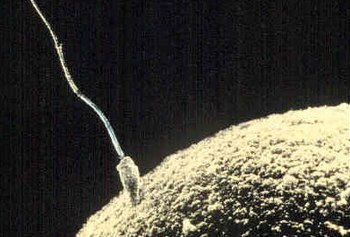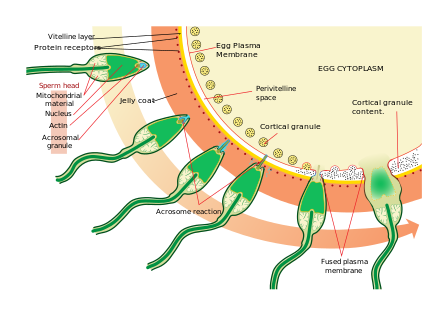| Spermatozoon | |
|---|---|
 |
|
| A sperm cell attempts to penetrate an ovum coat to fertilize it. | |
 |
|
| Diagram of a human spermatozoon | |
| Latin | spermatozoon |
| Gray's | subject #258 1243 |
| MeSH | Spermatozoa |
| Dorlands/Elsevier | Spermatozoa |
Sperm cells contribute approximately half of the nuclear genetic information to the diploid offspring (excluding, in most cases, mitochondrial DNA). In mammals, the sex of the offspring is determined by the sperm cell: a spermatozoon bearing a Y chromosome will lead to a male (XY) offspring, while one bearing an X chromosome will lead to a female (XX) offspring—the X chromosome. Sperm cells were first observed by Anton van Leeuwenhoek in 1677.[1]
Contents |
Mammalian spermatozoan structure, function, and size
Humans
The human sperm cell is the reproductive cell in males and will only survive in warm environments; once it leaves the male body the sperm's survival likelihood is reduced and it may die, thereby decreasing the total sperm quality. Sperm cells come in two types, "female" and "male". Sperm cells that give rise to female (XX) offspring after fertilization differ in that they carry an X-chromosome, while sperm cells that give rise to male (XY) offspring carry a Y-chromosome.In male humans, sperm cells consists of a head 5 µm by 3 µm and a tail 50 µm long.[2] The tail flagellates, which propels the sperm cell (at about 1–3 mm/minute in humans) by whipping in an elliptical cone.[3] Semen has an alkaline nature, and they do not reach full motility (hypermotility) until they reach the vagina where the alkaline pH is neutralized by acidic vaginal fluids. This gradual process takes 20–30 minutes. In this time, fibrinogen from the seminal vesicles forms a clot, securing and protecting the sperm. Just as they become hypermotile, fibrinolysin from the prostate dissolves the clot, allowing the sperm to progress optimally.
The spermatozoon is characterized by a minimum of cytoplasm and the most densely packed DNA known in eukaryotes. Compared to mitotic chromosomes in somatic cells, sperm DNA is at least sixfold more highly condensed.[4]
The specimen contributes with DNA/chromatin, a centriole and perhaps also an oocyte-activating factor (OAF).[5] It may also contribute with paternal messenger RNA (mRNA), also contributing to embryonic development.[5]
-
Electron micrograph of human spermatozoa magnified 3140 times.
Avoidance of immune system response
Glycoprotein molecules on the surface of ejaculated sperm cells are recognized by all human female immune systems, and interpreted as a signal that the cell should not be rejected. The female immune system might otherwise attack sperm in the reproductive tract. The specific glycoproteins coating sperm cells are also utilized by some cancerous and bacterial cells, some parasitic worms, and HIV-infected white blood cells, thereby avoiding an immune response from the host organism.[6]The blood-testis barrier, maintained by the tight junctions between the Sertoli cells of the seminiferous tubules, prevents communication between the forming spermatozoa in the testis and the blood vessels (and immune cells circulating within them) within the interstitial space. This prevents them from eliciting an immune response. The blood-testis barrier is also important in preventing toxic substances from disrupting spermatogenesis.
Spermatozoa in other organisms
See also: Sperm and Female sperm storage
Animals
Fertilization relies on spermatozoa for most sexually reproductive animals.The fruit fly has the largest known spermatozoon relative to its size.[7] Drosophila melanogaster produces sperm that can be up to 1.8 mm[8] in size. The incredibly long tail is thought to block other sperm from entering the egg. The entire sperm, tail included, gets incorporated into the oocyte cytoplasm.[9]
The wood mouse Apodemus slvaticus possesses spermatozoa with falciform morphology. What makes these gametocytes even more unique is the presence of an apical hook on the sperm head. This hook is used to attach to the hooks or to the flagella of other spermatozoa. Aggregation is caused by these attachments and mobile trains result. These trains provide improved motility in the female reproductive tract and are a means by which fertilization is promoted.[10]
Sea urchins such as Arbacia punctulata—are ideal organisms to use in sperm research, they spawn large numbers of sperm into the sea, making them well-suited as model organisms for experiments.
Plants, algae and fungi
The gametophytes of bryophytes, ferns and some gymnosperms produce motile sperm cells, contrary to pollen grains employed in most gymnosperms and all angiosperms. This renders sexual reproduction in the absence of water impossible, since water is a necessary medium for sperm and egg to meet. Algae and lower plant sperm cells are often multi-flagellated (see image) and thus morphologically different from animal spermatozoa.Some algae and fungi produce non-motile sperm cells, called spermatia. In higher plants and some algae and fungi, fertilization involves the migration of the sperm nucleus through a fertilization tube (e.g. pollen tube in higher plants) to reach the egg cell.
Spermatozoa production in mammals
Main article: Spermatogenesis
Spermatozoa are produced in the seminiferous tubules of the testes in a process called spermatogenesis. Round cells called spermatogonia divide and differentiate eventually to become spermatozoa. During copulation the cloaca or vagina gets inseminated, and then the spermatozoa move through chemotaxis to the ovum inside a Fallopian tube or the uterus.Spermatozoa activation
Main article: Acrosome reaction

Acrosome reaction on a Sea Urchin cell
The initial change is called "hyperactivation", which causes a change in spermatozoa motility. They swim faster and their tail movements become more forceful and erratic.
A recent discovery links hyperactivation to a sudden influx of calcium ion into the tails. The whip-like tail (flagellum) of the sperm is studded with ion channels formed by proteins called CatSper. These channels are selective, allowing only calcium ion to pass. The opening of CatSper channels is responsible for the influx of calcium. The sudden rise in calcium levels causes the flagellum to form deeper bends, propelling the sperm more forcefully through the viscous environment. Sperm hyperactivity is necessary for breaking through two physical barriers that protect the egg from fertilization.
The second process in sperm activation is the acrosome reaction. This involves releasing the contents of the acrosome, which disperse, and the exposure of enzymes attached to the inner acrosomal membrane of the sperm. This occurs after the sperm first meets the egg. This lock-and-key type mechanism is species-specific and prevents the sperm and egg of different species from fusing. There is some evidence that this binding is what triggers the acrosome to release the enzymes that allow the sperm to fuse with the egg.
ZP3, one of the proteins that make up the zona pellucida, then binds to a partner molecule on the sperm. Enzymes on the inner acrosomal membrane digests the zona pellucida. After the sperm penetrates the zona pellucida, part of the sperm's cell membrane then fuses with the egg cell's membrane, and the contents of the head diffuse into the egg.
Upon penetration, the oocyte is said to have become activated. It undergoes its secondary meiotic division, and the two haploid nuclei (paternal and maternal) fuse to form a zygote. In order to prevent polyspermy and minimise the possibility of producing a triploid zygote, several changes to the egg's zona pellucida renders them impenetrable shortly after the first sperm enters the egg.
Artificial storage
Spermatozoa can be stored in diluents such has the Illini Variable Temperature (IVT) diluent, which have been reported to be able to preserve high fertility of spermatozoa for over seven days.[12] The IVT diluent is composed of several salts, sugars and antibacterial agents and gassed with CO2.[12]Semen cryopreservation can be used for far longer storage durations. For human spermatozoa, the longest reported successful storage with this method is 21 years.[13]
References
- ^ "Timeline: Assisted reproduction and birth control". CBC News. Retrieved 2006-04-06.
- ^ Smith, D.J. (2009). "Human sperm accumulation near surfaces: a simulation study". Journal of Fluid Mechanics 621: 295. doi:10.1017/S0022112008004953. Retrieved 20 May 2012.
- ^ Sumio Ishijima, Shigeru Oshio, Hideo Mohri, "Flagellar movement of human spermatozoa", Gamete research, 1986, vol. 13, no3, pp. 185–197 (27 ref.) [1]
- ^ Ward WS, Coffey DS (1991). "DNA packaging and organization in mammalian spermatozoa: comparison with somatic cells". Biol. Reprod. 44 (4): 569–74. doi:10.1095/biolreprod44.4.569. PMID 2043729.
- ^ a b Developmental sperm contributions: fertilization and beyond Gerardo Barroso, M.D., M.Sc.a, Carlos Valdespin, M.D.a, Eva Vega, M.Sc.a, Ruben Kershenovich, M.D.a, Rosaura Avila, B.Sc.a, Conrado Avendaño, M.D.b, Sergio Oehninger, M.D., Ph.D.b. FertStert, Volume 92, Issue 3, Pages 835-848 (September 2009)
- ^ "Sperm clue to 'disease immunity'". BBC News. 2007-12-17.
- ^ Than, Ker. "Longest Known Sperm Create Paradox of Nature". www.livescience.com. Retrieved 20 May 2012.
- ^ Pitnick, S., Spicer, G. S., & Markow, T. A. (1995). How long is a giant sperm Nature, 375(6527), 109. doi:10.1038/375109a0
- ^ Gilbert, Scott F., Developmental Biology, Eighth Edition. 2006. Sinauer Associates, pp. 254
- ^ Moore, Harry et al., Exceptional sperm cooperation in Wood Mouse. Nature 418, 174–177 (2002)
- ^ Gnessi L, Fabbri A, Silvestroni L, Moretti C, Fraioli F, Pert CB, Isidori A. (1986). "Evidence for the presence of specific receptors for N-formyl chemotactic peptides on human spermatozoa.". J Clin Endocrinol Metab 63 (4): 841–6. doi:10.1210/jcem-63-4-841. PMID 3018025
- ^ a b Watson, P. F. (1993). "The potential impact of sperm encapsulation technology on the importance of timing of artificial insemination: A perspective in the light of published work". Reproduction, Fertility and Development 5 (6): 691. doi:10.1071/RD9930691.
- ^ Planer NEWS and Press Releases > Child born after 21 year semen storage using Planer controlled rate freezer 14/10/2004
External links
| Wikimedia Commons has media related to: Spermatozoon diagrams |
| [hide] | ||||||||||||||
|---|---|---|---|---|---|---|---|---|---|---|---|---|---|---|
| Internal |
|
|||||||||||||
| External |
| |||||||||||||




Комментариев нет:
Отправить комментарий